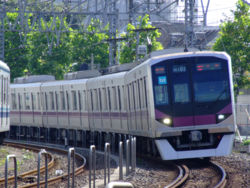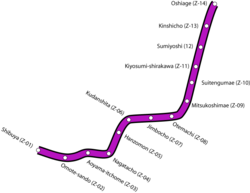Tokyo Metro Hanzomon Line
The Tokyo Metro Hanzōmon Line (東京地下鉄半蔵門線 Tōkyō Chikatetsu Hanzōmon-sen?) is a metro line in Tokyo, Japan, administered by the Tokyo Metro. Its color on maps is purple. Stations on the Hanzōmon Line carry the letter Z followed by a number.
The 16.8 km line serves the wards of Shibuya, Minato, Chiyoda, Chūō, Koto and Sumida. Hanzomon Line trains interoperate with the Tokyu Den-en-toshi Line from Shibuya Station and with the Tobu Isesaki Line from Oshiage Station. Through-service trains between Tokyu Chūō-Rinkan and Tobu Minami-Kurihashi cover a total distance of 98.5 km in a single run.
The Hanzomon Line has interchanges with all other Tokyo Metro and Toei lines, except the Hibiya Line. It interchanges with the Ginza Line at four stations.
The line is named after the west gate of the Imperial Palace (Hanzomon), which in turn is named after ninjutsu master Hattori Hanzo.
Development
The Hanzomon Line was first planned in 1971, along with the Chiyoda Line and Yurakucho Line, as a reliever line for the heavily congested Ginza Line. Its initial routing was from Futako-Tamagawa Station on the Tokyu Den-en-toshi Line to a new station in the Fukagawa district of Koto Ward. In 1985, a second draft plan from the Ministry of Transportation moved the Hanzomon Line's final terminus to Matsudo, Chiba Prefecture. During the planning stage, it was known as Line 11.
Construction began in 1972 and most of the line was expected to open in 1975. However, the poor economy in Japan had depressed the Teito Rapid Transit Authority's receipts during that time, which considerably delayed the construction of new lines. In 1978, the first section of the Hanzomon Line opened, from Shibuya to Aoyama-itchome, and through service with the Den-en-toshi Line commenced.
The line was extended to Nagatacho in 1979 without major incident. However, the next extension posed political problems, as the original plan had the line run directly under the Imperial Palace to Otemachi. TRTA decided to divert the route around the north side of the Imperial Palace, which required the construction of three new stations. An eminent domain battle erupted with landowners along the proposed route, which delayed the completion of the next stage of the line. Hanzomon Station opened in 1982, and the full extension around the Imperial Palace, terminating at Mitsukoshi-mae, was completed in 1989.
Since then, there have been further extensions to Suitengu-mae (1990) and finally Oshiage (2003). The Ministry of Transportation estimated in 2000 that the line would be completed (i.e. extended to Matsudo) in 2015. However, Tokyo Metro stated in its initial public offering that its construction operations would cease once the Fukutoshin Line is completed, which casts some doubt as to whether the Matsudo extension will actually be built.
Stations
- Note: The Ginza and Hanzomon Line stations at Shibuya are not directly connected, so a new ticket is required in order to transfer; Omotesando, where the two lines run on the same platforms, is a more convenient transfer point.
Mass transit in Tokyo | |
|---|---|
| Metro lines (Subway) | Chiyoda · Fukutoshin · Ginza · Hanzōmon · Hibiya · Marunouchi · Namboku · Tōzai · Yūrakuchō |
| Toei lines | Subway: Asakusa · Mita · Ōedo · Shinjuku Streetcar: Arakawa |
| JR lines | Yamanote · Chūō · Chūō-Sōbu · Jōban · Keihin-Tōhoku · Keiyō · Saikyō · Shōnan-Shinjuku · Sōbu · Tōkaidō · Yokosuka |
| Other networks | Keikyū · Keiō · Keisei · Nippori-Toneri · Odakyū · Seibu · Tōbu · Tokyo Monorail · Tōkyū · TWR · TX · Yurikamome |
| Around Tokyo | Chiba Monorail · Enoden · Hokusō · Saitama Rapid · Saitama New Urban · Shin-Keisei · Shōnan Monorail · Sōtetsu · Tama Monorail · Tōyō Rapid · Yokohama MM · Yokohama Subway |
| Terminals | Asakusa · Ikebukuro · Kita-Senju · Oshiage · Shibuya · Shinagawa · Shinjuku · Tōkyō · Ueno |
| Miscellaneous | PASMO · Passnet · Suica · Transportation in Greater Tokyo |


